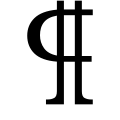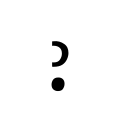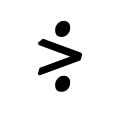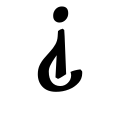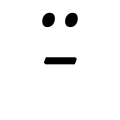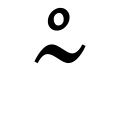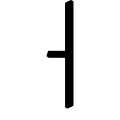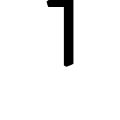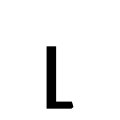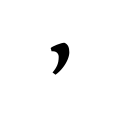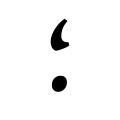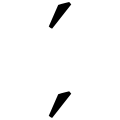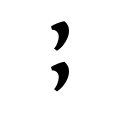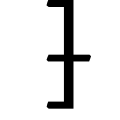Category:Unicode 2E00-2E7F Supplemental Punctuation
Vai alla navigazione
Vai alla ricerca
Unicode block (U+2E00-2E7F) | |||||
| Carica un file multimediale | |||||
| Istanza di |
| ||||
|---|---|---|---|---|---|
| Parte di | |||||
| Preceduto da | |||||
| Seguito da | |||||
| |||||
| Character list |
|---|
|
Sottocategorie
Questa categoria contiene le 4 sottocategorie indicate di seguito, su un totale di 4.
U
- Coronis (textual symbol) (9 F)
- Reversed question mark (14 F)
- ⹋ (3 F)
File nella categoria "Unicode 2E00-2E7F Supplemental Punctuation"
Questa categoria contiene 59 file, indicati di seguito, su un totale di 59.
-
U+2E2C.svg 16 × 16; 1 KB
-
U+2E2D.svg 16 × 16; 2 KB
-
U+2E39.svg 16 × 16; 2 KB
-
U+2E3F.svg 16 × 16; 1 KB
-
U+2E43.svg 16 × 16; 917 byte
-
U+2E4C.svg 16 × 16; 1 KB
-
U+2E4D.svg 16 × 16; 2 KB
-
U+2E4E.svg 16 × 16; 1 KB
-
U+2E4F.svg 16 × 16; 2 KB
-
U+2E50.svg 16 × 16; 471 byte
-
U+2E51.svg 16 × 16; 471 byte
-
UCB Supplemental Punctuation.png 1 900 × 1 161; 37 KB
-
Unicode 0x2E14.svg 16 × 16; 1 KB
-
Unicode 0x2E15.svg 16 × 16; 1 KB
-
Unicode 0x2E16.svg 16 × 16; 1 KB
-
Unicode 0x2E18.svg 16 × 16; 2 KB
-
Unicode 0x2E19.svg 16 × 16; 4 KB
-
Unicode 0x2E1A.svg 15 × 15; 4 KB
-
Unicode 0x2E1B.svg 16 × 16; 2 KB
-
Unicode 0x2E1C.svg 15 × 15; 3 KB
-
Unicode 0x2E1D.svg 15 × 15; 2 KB
-
Unicode 0x2E1E.svg 16 × 16; 1 KB
-
Unicode 0x2E1F.svg 16 × 16; 1 KB
-
Unicode 0x2E20.svg 16 × 16; 875 byte
-
Unicode 0x2E21.svg 16 × 16; 875 byte
-
Unicode 0x2E22.svg 16 × 16; 858 byte
-
Unicode 0x2E23.svg 16 × 16; 823 byte
-
Unicode 0x2E24.svg 16 × 16; 843 byte
-
Unicode 0x2E25.svg 16 × 16; 872 byte
-
Unicode 0x2E2F.svg 16 × 16; 1 KB
-
Unicode 0x2E32.svg 16 × 16; 1 006 byte
-
Unicode 0x2E34.svg 16 × 16; 1 016 byte
-
Unicode 0x2E35.svg 16 × 16; 1 KB
-
Unicode 0x2E3A.svg 24 × 16; 783 byte
-
Unicode 0x2E3B.svg 35 × 16; 785 byte
-
Unicode 0x2E3C.svg 15 × 15; 3 KB
-
Unicode 0x2E3D.svg 16 × 16; 2 KB
-
Unicode 0x2E3E.svg 16 × 16; 2 KB
-
Unicode 0x2E40.svg 15 × 15; 4 KB
-
Unicode 0x2E41.svg 16 × 16; 1 003 byte
-
Unicode 0x2E42.svg 16 × 16; 1 KB
-
Unicode 0x2E44.svg 15 × 15; 4 KB
-
Unicode 0x2E45.svg 15 × 15; 3 KB
-
Unicode 0x2E46.svg 15 × 15; 5 KB
-
Unicode 0x2E47.svg 15 × 15; 3 KB
-
Unicode 0x2E48.svg 15 × 15; 4 KB
-
Unicode 0x2E49.svg 16 × 16; 1 KB
-
Unicode 0x2E4A.svg 15 × 15; 4 KB
-
Unicode 0x2E53.svg 16 × 16; 1 KB
-
Unicode 0x2E54.svg 16 × 16; 1 KB
-
Unicode 0x2E55.svg 15 × 15; 4 KB
-
Unicode 0x2E56.svg 15 × 15; 4 KB
-
Unicode 0x2E57.svg 15 × 15; 4 KB
-
Unicode 0x2E58.svg 15 × 15; 4 KB
-
Unicode 0x2E59.svg 15 × 15; 3 KB
-
Unicode 0x2E5A.svg 15 × 15; 3 KB
-
Unicode 0x2E5B.svg 15 × 15; 3 KB
-
Unicode 0x2E5C.svg 15 × 15; 3 KB
-
Unicode 0x2E5D.svg 15 × 15; 3 KB




